Dog owners often find themselves perplexed and slightly amused when they witness their freshly bathed pet diving into the dirt. This seemingly contradictory behavior, where dogs roll in the dirt immediately after a bath, is quite common and has several explanations grounded in canine instincts and behavior. While it may seem counterintuitive to humans, for dogs, this act is a natural response to various stimuli and can be related to their ancestry, communication, and even personal comfort.

One of the primary reasons dogs engage in this behavior is to mask the artificial scents from grooming products with their own natural smell, which is important for their sense of identity and interaction with other dogs. Rolling in dirt may also serve as a way to relieve skin irritations or simply as a post-bath celebration. Understanding these motivations can help owners better comprehend their pets and manage post-bath antics effectively.
Key Takeaways
- Dogs often roll in dirt after a bath to cover up scents and reclaim their natural smell.
- The behavior is instinctual and can serve as a means for communication or relief from discomfort.
- Recognizing the reasons can assist in managing and preventing unwanted rolling.
Understanding Canine Instincts
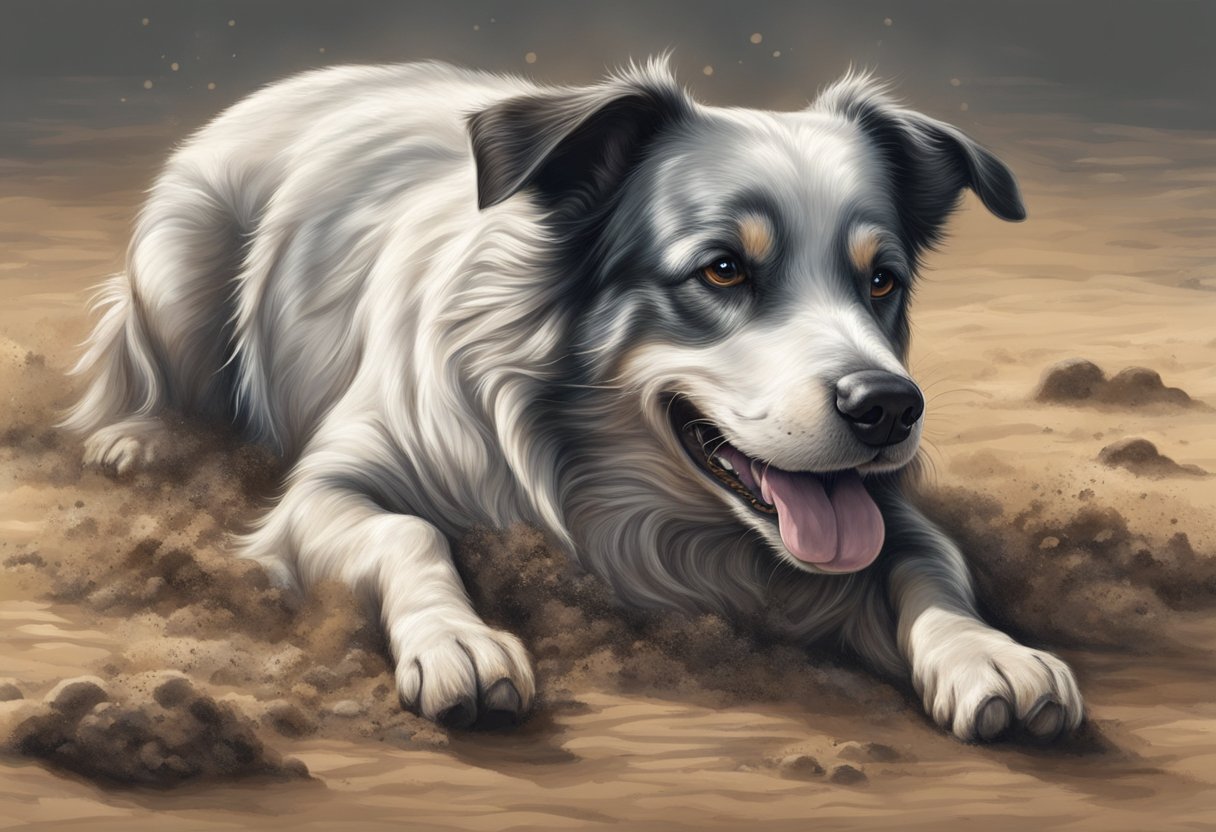
Dogs’ instinctual behaviors can often seem peculiar, but they have evolved over thousands of years. These instincts serve specific purposes and are deeply ingrained within a dog’s psyche, often mirroring the natural behavior of their wild ancestors.
Inherited Behaviors from Wild Ancestors
Dogs have retained many behaviors from their wild ancestors, wolves. These behaviors have been passed down through generations and are apparent in various actions they take. For instance, rolling in dirt is a natural behavior that wolves use for several survival mechanisms, such as masking their scent to sneak up on prey or to avoid predators.
Masking Their Scent with Dirt
One primary reason dogs roll in dirt after a bath is to mask their scent. Bathing removes the smells that they naturally produce, which include pheromones and natural oils. By rolling in dirt, dogs may be trying to replace those smells and reassert their natural state, a practice that would be crucial in the wild when encountering predators or other wolves.
Instinctual Rolling for Scent Distribution
Another aspect of this behavior is scent distribution. When a dog rolls in dirt, it’s also spreading its own scent, which is a way of marking territory and communicating with other dogs. The instinct to leave their scent is strong and goes beyond just territory—it’s a way for dogs to tell a story about where they’ve been and what they’ve encountered, similar to how wolves communicate with other members of their pack.
Bath Time Dynamics
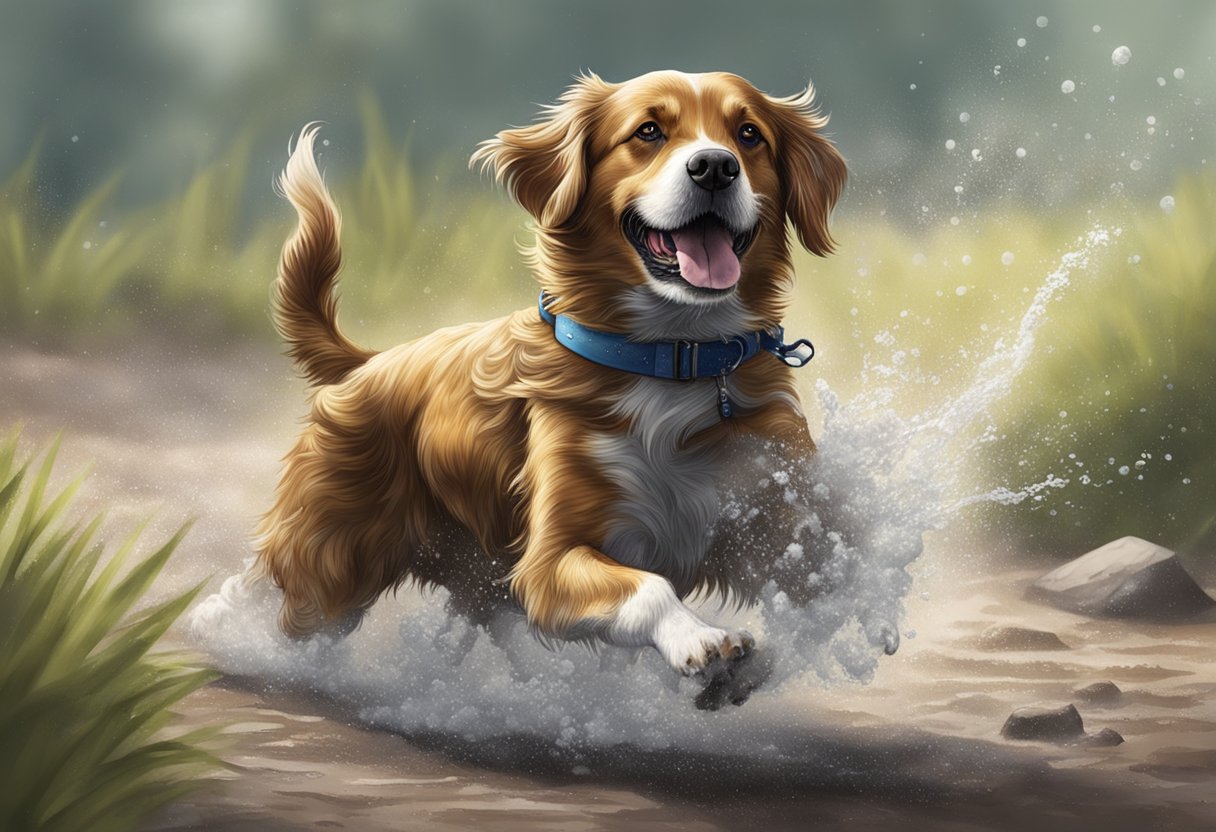
When it comes to understanding why dogs roll in dirt after a bath, two key factors are at play: the negative association they may have with baths, and their instinct to replace artificial scents with their natural one.
Negative Association with Baths
Many dogs dislike baths, and the act of bathing can be a stressful experience for them. If a dog has a negative association with bath time, they may express relief and return to a state of comfort by rolling in the dirt as soon as they have the opportunity. This behavior is their way of coping with the stress associated with baths and the feelings of vulnerability they experience when their smell changes due to shampoos.
Replacing Artificial Scents
A common reason dogs roll in dirt post-bath is to replace artificial scents from soaps and shampoos with their more familiar scent. Dogs have a strong sense of smell, and the scents from soaps can be overwhelming and somewhat alien to them. Rolling in dirt allows them to reclaim their natural smell, which is comforting and essential for their interaction with other dogs and their environment.
Communication and Behavioral Aspects
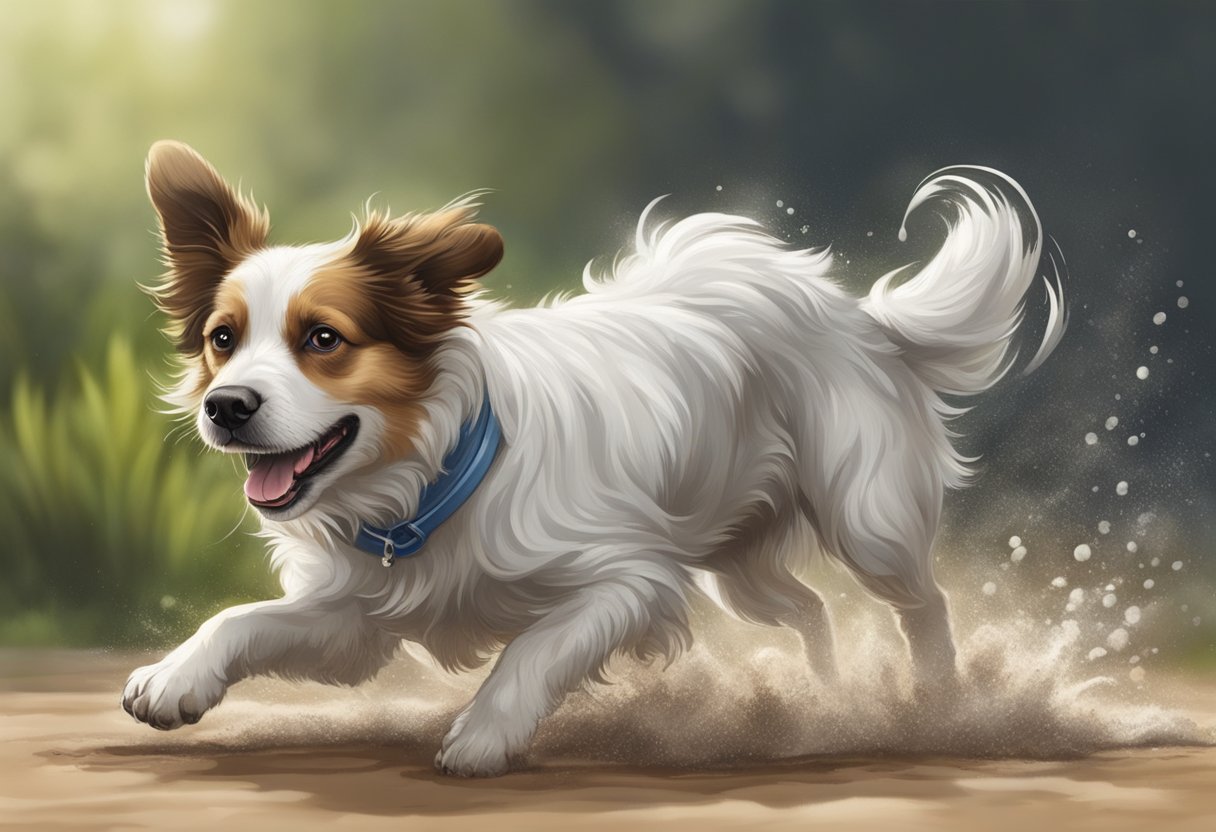
Dogs communicate complex emotions and social hierarchies through body language, including rolling in dirt after a bath. This behavior can signify a range of messages from social signaling to uninhibited playfulness.
Social Signals and Dominance
When dogs roll in dirt, they may be conveying social signals related to dominance. By coating themselves in a familiar scent, they reaffirm their presence and status within their social environment. The act of rolling can also disrupt the scent applied during their bath, which may be perceived as an artificial overlay by other dogs in their pack, allowing them to express their natural state and dominance.
Play and Joy Expression
This behavior is also a manifestation of play and joy. By energetically rolling in the dirt immediately after a bath, dogs are often expressing happiness and engaging in a playful act that is innately satisfying. It is an exuberant expression that can be attributed to the sheer joy of being in a state that feels more natural to them, devoid of any shampoos or cleaning products.
Physical and Health-Related Causes

Following a bath, dogs may roll in the dirt due to various physical and health-related issues. These behaviors are often driven by an instinctive need to address discomfort or the presence of parasites.
Relieving Skin Discomfort
After bathing, dogs may experience skin discomfort due to shampoos that remove their natural oils. This sudden change can result in an itchy sensation, prompting dogs to roll in dirt to alleviate the discomfort. This is their way of scratching an itch or soothing irritation. Some skin conditions or allergies can exacerbate this reaction, making the post-bath roll a relief-seeking behavior for any lingering skin problem.
Response to Parasites
Similarly, rolling in dirt could be an attempt to dislodge parasites such as fleas or ticks. If a dog is suffering from a parasitic skin infection, the act of rolling may help remove these pests physically. Dogs might engage in this behavior instinctively even after a bath meant to clean away such parasites, as the sensation caused by parasites might still linger.
Canine Post-Bath Rituals
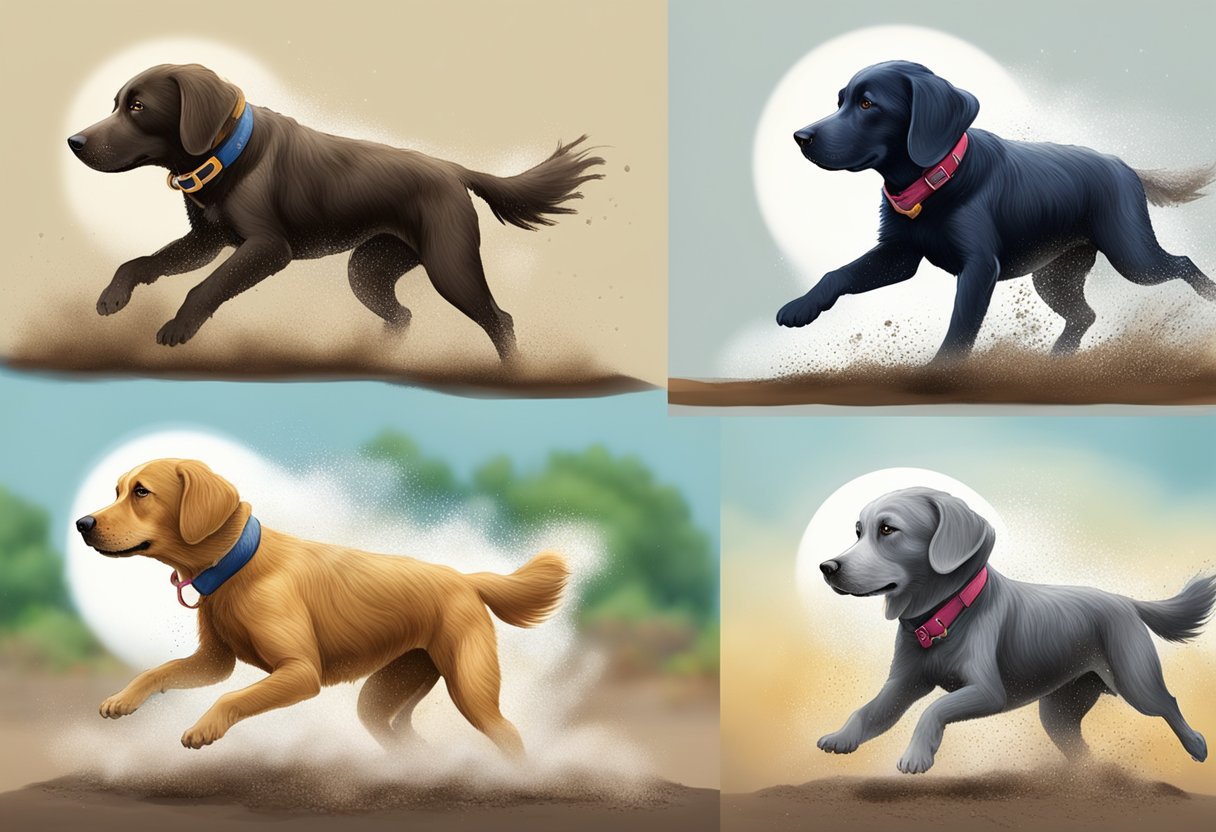
After a bath, dogs often engage in behaviors that serve both physiological and psychological purposes. Specifically, these rituals include rolling in dirt, which can be a strategy for cooling down and drying off, as well as a means of obtaining positive reinforcement.
Cooling Down and Drying Off Strategy
When dogs roll in dirt after a bath, they may be employing a natural cooling and drying off technique. The fresh layer of soil helps to evaporate moisture from their fur, aiding in the drying process. Additionally, the coolness of the dirt can provide relief and help to cool down their body temperature after the warm water of a bath.
Rolling as Positive Reinforcement
Rolling in dirt acts as a form of positive reinforcement for many canines. This behavior often results in attention from their owners, whether it’s laughter or a light-hearted reprimand, which dogs may interpret as a form of engagement or play. Thus, when they roll in dirt after a bath, they’re not only returning to their natural scent but also possibly associating the action with positive social interactions with their human companions.
Interventions and Prevention
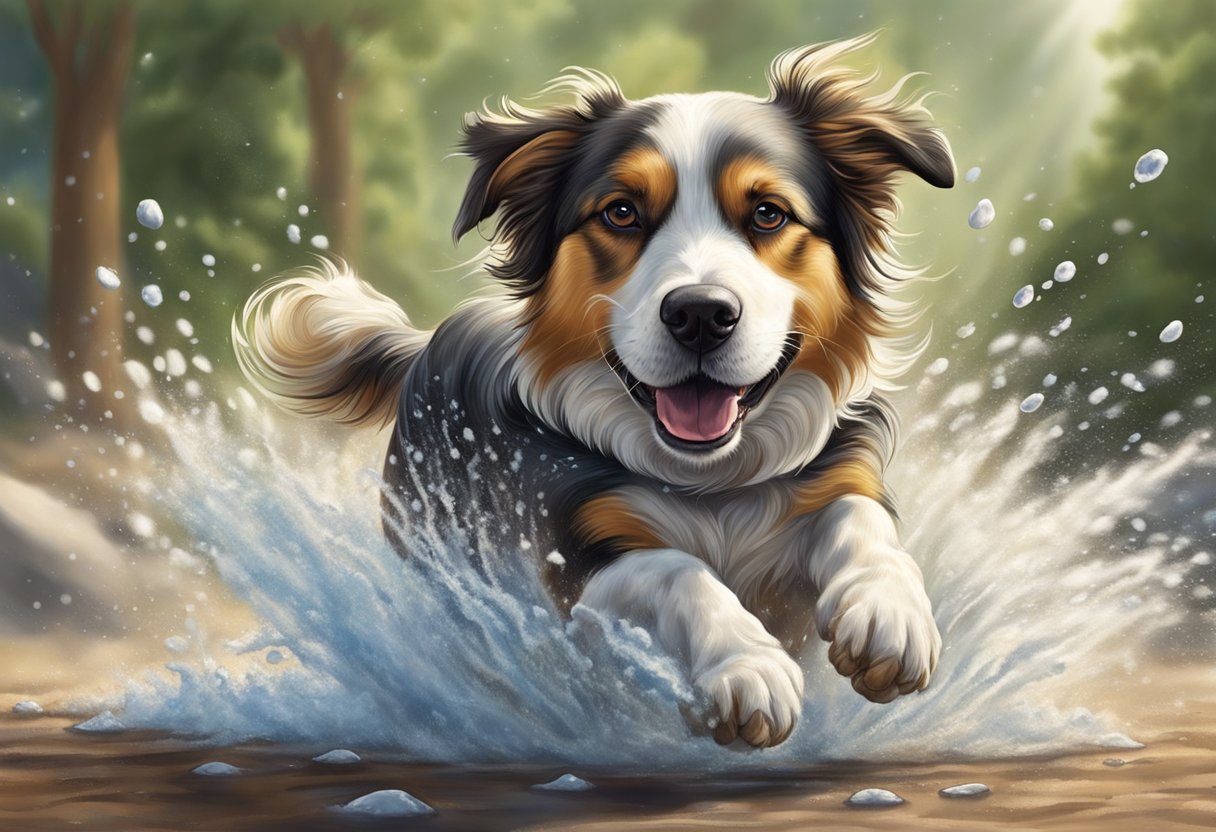
When aiming to curb the habit of dogs rolling in dirt after a bath, a multifaceted approach involving professional advice, training, and product selection is essential. These strategies assist in reducing the likelihood of this behavior and provide comfort for both the dog and the owner.
Consulting with Veterinarians
Veterinarians can offer insights into whether a dog’s compulsion to roll in dirt post-bath may be correlated with skin discomfort or anxiety. If a dog experiences relief from itching by rolling in dirt, a veterinarian can recommend appropriate treatments or diets that alleviate skin irritations. It’s crucial to rule out any medical causes before attributing the behavior solely to instinct.
Behavioral Training and Reinforcement
Implementing behavioral training sequences soon after bathing can encourage alternative actions. Positive behavioural reinforcement helps in establishing a pattern where the dog learns that staying clean is rewarding. Immediate engagement in play or providing treats can distract them from the urge to roll in the dirt.
Choosing Suitable Bath Products
Selecting soaps and bathing products that preserve a dog’s natural oils is critical. Using mild, unscented products can prevent the eradication of a dog’s familiar scent, which is commonly a trigger for dirt rolling. Bath products enriched with natural ingredients are less likely to cause irritation, reducing the dog’s need to seek relief in the dirt.
Additional Considerations
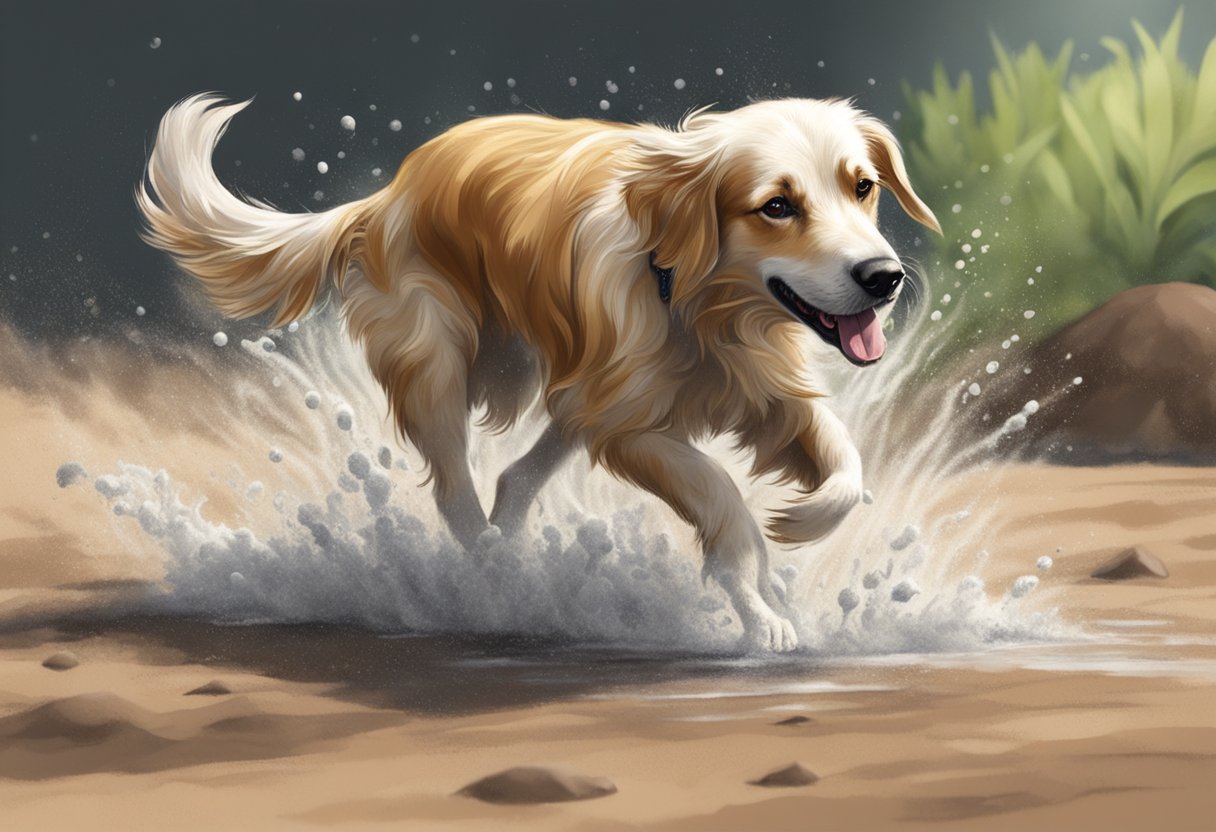
When assessing why dogs roll in the dirt after a bath, it is crucial to consider environmental factors and individual differences among dogs. These elements play a significant role in this behavior.
Environmental Influences on Rolling Behavior
Dogs often interact with their environment based on their sensory experiences. Grass and dirt are not merely surfaces to them; they are rich with various scents that canines find irresistible. Post-bath, dogs may seek out these scents to mask synthetic odors from grooming products and to restore their natural oils that help protect their coat and skin.
Understanding Individual Differences in Dogs
Each dog possesses a unique personality and set of preferences. While some might indulge in rolling in the dirt to rejoice in newfound freedom after a bath, others might be driven by an instinct to reclaim their natural scent. Observing a dog’s behavior over time provides insight into their specific motives and can help distinguish between a habitual action and one that may indicate an underlying skin irritation or discomfort.
Frequently Asked Questions

Understanding dogs’ post-bath behavior can be quite perplexing. This section aims to demystify why dogs exhibit certain behaviors, such as rolling in the dirt, after their baths.
What compels dogs to roll in the grass following a bath?
Dogs often roll in the grass after a bath as an instinctive act to revert to their natural scent. The perfumes from shampoos and soaps might be overwhelming to a dog’s sensitive nose, prompting them to reclaim their own smell by rolling in the grass.
How can a dog’s rolling in poop be explained in terms of their behavior?
Rolling in poop is a natural behavior that can be traced back to a dog’s ancestral need to mask their scent for hunting or to communicate with other dogs. It’s a way to cover their own scent with a more potent odor.
What should be done when a puppy appears traumatized after bathing?
When a puppy seems traumatized after bathing, it’s important to slowly acclimate them to the experience. Keeping bath time calm and positive with treats and praise can help a puppy associate bathing with a positive activity.
Can a correlation be made between a dog’s rolling in dirt and a cat’s similar behavior?
While dogs roll in dirt to mask their scent or relieve irritation, cats often engage in dirt-rolling for grooming purposes and to cool down. Though a similar action, cats and dogs have different motivations for their behavior.
What causes dogs to exhibit heightened excitement and roll on the ground post-walk?
Heightened excitement and rolling on the ground post-walk can be attributed to a dog’s exposure to new scents and environmental stimuli during their walk which can trigger the instinctual behavior of scent marking or the joy of discovering an especially intriguing smell.
What strategies might prevent a dog from engaging in dirt-rolling immediately after being bathed?
To discourage dirt-rolling after a bath, distracting the dog with play or keeping them indoors for a while can be effective. Using unscented or mildly scented products may also reduce the urge to roll in the dirt to get rid of strong fragrances.
